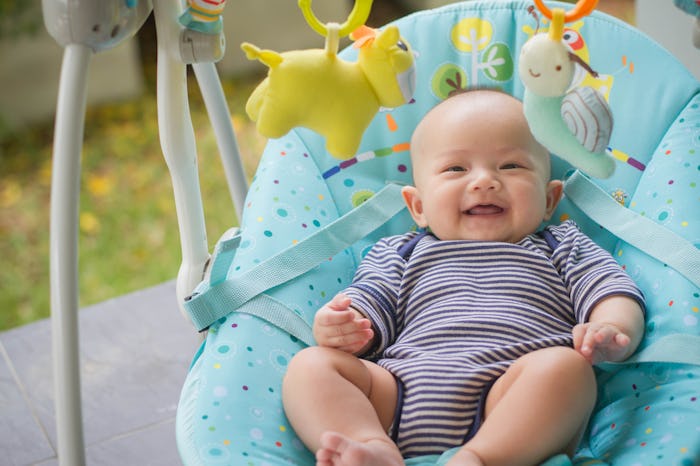Life
These Updated Safety Standards For Baby Bouncers Are Necessary For All Parents To Know
Baby bouncer seats can be a lifesaver. They are a convenient way to soothe a fussy baby when nothing else will, or your hands are totally tied up. But as appealing as they may be, there are some safety concerns that come along with using such seats. And because of these risks, the U.S. Consumer Product Safety Commission has updated the safety requirements for baby bouncers, which will hopefully alleviate parents' fears and hesitations when using them with their little one.
If you're in the market for a new infant bouncer seat, you'll notice that they all will now come with fall hazard warning labels placed on the front of the seat near the location of the baby's head and shoulders. According to Sandhills Express, this new mandatory standard, approved by the CPSC, is intended to "prevent deaths and injuries" to the infants that are being placed in the seats.
The serious risk that the CPSC is looking to combat with these new hazard labels is the large number of falls associated with infant bouncer seats. Consumer Affairs reported that between Jan. 1, 2006 and July 6, 2016, there were 347 incidents involving bouncer seats reported to CPSC — including 12 fatalities and 54 injuries. Of the incidents resulting in the reported fatalities, the major cause of death was suffocation caused by unrestrained babies flipping over in a bouncer or the bouncer itself falling over.
There are a number of actions that parents can take to ensure that their babies are safe while in baby bouncer seats. According to Consumer Affairs, here are a few general guidelines parents and caregivers can follow:
- Bouncer seats should always be used on the floor, and never on a countertop, table, or some other elevated surface
- Do not sit the bouncer on a soft surface, such as a bed or surface, as this can lead to suffocation if it tips over
- Always fasten your baby into restraints and harnesses, even if they're sleeping
- Don't go far so the baby is in your sight
- Once the baby is able to sit up by themselves — or reaches 20 lbs. or manufacturer’s recommended maximum weight — stop using the bouncer
As Netmums noted, infant bouncer seats should come with a three-point safety harness for securing your baby from slipping out of it or getting tangled while in the bouncer. Additionally, while most bouncer seats can be used from birth, they may not be appropriate for premature babies. Netmums explained that many bouncer seats also have a weight restriction but regardless of how much your child weighs, it is recommended that you stop using the seat when your baby can sit, roll, or crawl without your help. If you continue to use the chair once your child is mobile, there are risks of the chair flipping over.
Parents should also be mindful about letting their babies sleep in the bouncers, as a recent study published in The Journal of Pediatrics found that sitting devices such as car seats, swings, and bouncers can lead to injury and even death if babies sleep in them. Asphyxiation and strangulation were leading causes of death in these cases. An article published in Slate explained how positional asphyxia comes into play with bouncer seats. As the magazine explained, this happens when babies are too young to hold up their heads — usually younger than 4 months — they may slump over while sitting down in bouncer or car seats. For example, if the child's chin is resting against his or her chest, the airway can constrict and lead to suffocation.
Allowing babies to sleep in these seats at is just an all-around bad idea, but it is made worse when children are unsupervised. According to Parents, sleep-related deaths are the leading cause of death in babies between 1 and 12 months old. Which is why it's important that babies and young children are not be unsupervised in sitting devices — awake or asleep. Ultimately, the safest place for a baby to sleep is on his or her back, in a crib with a firm mattress and no loose bedding.
All of this is not to say that bouncer seats are a bad thing — anything that helps to soothe a fussy baby is a win for any parent. However, it is important that parents use these products correctly and safely. Hazard labels such as the one recently approved by the CPSC will help ensure that parents are informed and able to do so.
Watch Romper's new video series, Romper's Doula Diaries:
Check out the entire Romper's Doula Diaries series and other videos on Facebook and the Bustle app across Apple TV, Roku, and Amazon Fire TV.
